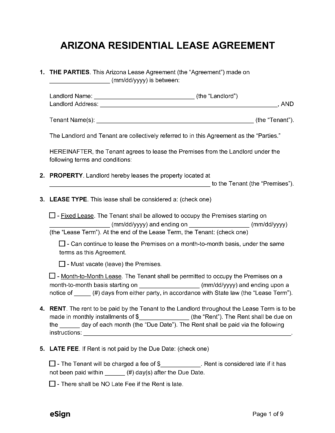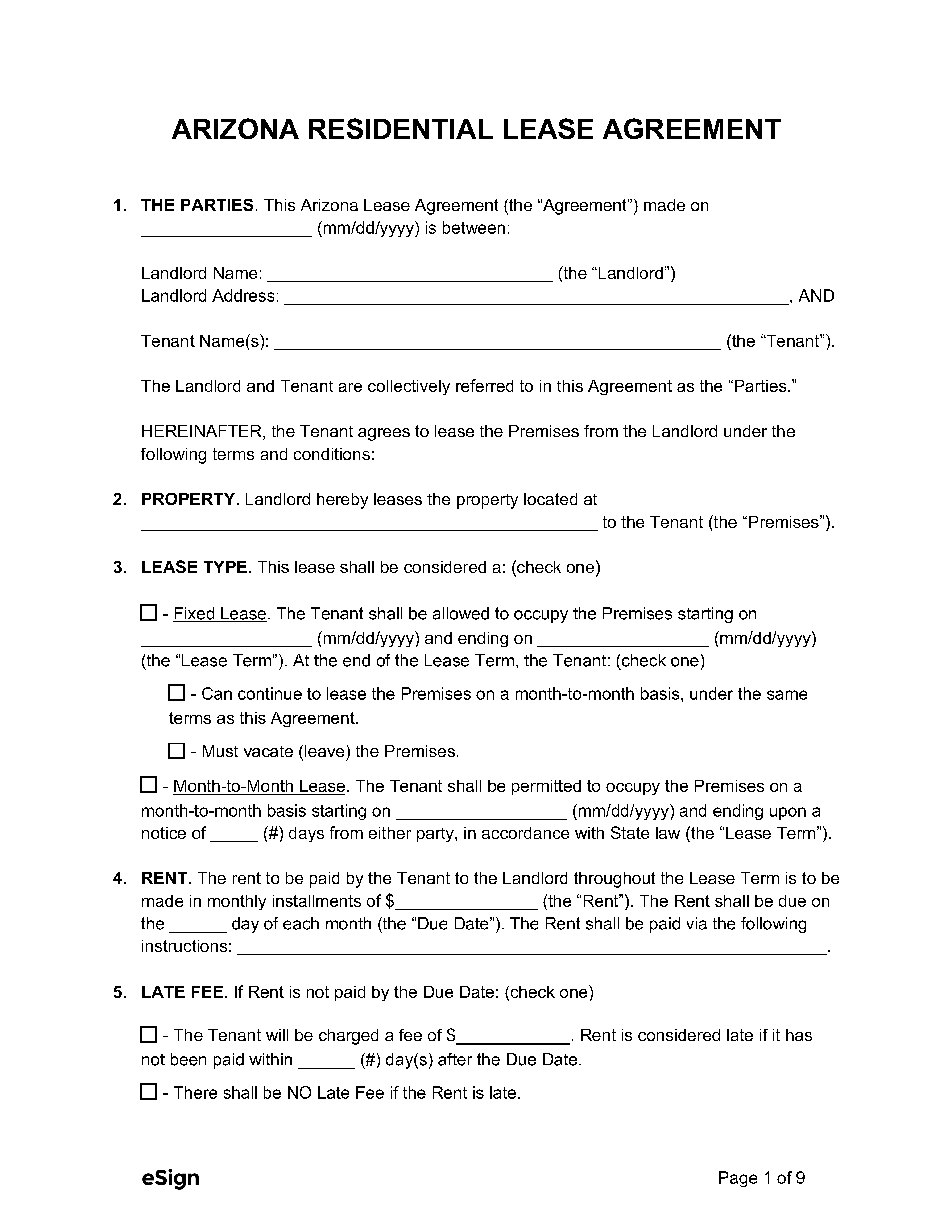
An Arizona lease agreement is a contract between a tenant and landlord that establishes terms for renting a residential or commercial property. A lease defines essential details like the monthly rent, payment dates, lease duration, and both party’s rights and responsibilities. It also outlines the penalties for violating the rental conditions (e.g., late fees, deposit deductions, lease termination).
An Arizona lease agreement is a contract between a tenant and landlord that establishes terms for renting a residential or commercial property. A lease defines essential details like the monthly rent, payment dates, lease duration, and both party’s rights and responsibilities. It also outlines the penalties for violating the rental conditions (e.g., late fees, deposit deductions, lease termination).
PDF Download
An Arizona lease agreement is a contract between a tenant and landlord that establishes terms for renting a residential or commercial property. A lease defines essential details like the monthly rent, payment dates, lease duration, and both party’s rights and responsibilities. It also outlines the penalties for violating the rental conditions (e.g., late fees, deposit deductions, lease termination).
4.8 | 49 Ratings Downloads: 5,918
Rental Application – A form used by residential landlords to collect information and perform background checks on lease applicants.
Maximum Amount ($) – The maximum security deposit amount that can be demanded by a landlord is the equivalent of one and a half month’s rent. [10]
Collecting Interest – Landlords are not required to pay interest on a security deposit.
Returning to Tenant – After the tenant moves out and requests the return of their security deposit, the landlord has 14 business days to complete the refund process. [13]
Itemized List Required? – Yes, an itemized list of deductions must provided along with the return of the tenant’s security deposit. [14]
Separate Bank Account? – No, landlords have no legal requirements to maintain a security deposit in a separate bank account.
General Access – Landlords must give tenants two days’ notice before entering the premises for any non-emergency reason. [15]
Immediate Access – A landlord may enter the premises without notice in an emergency. [16]
Grace Period – There is no grace period in Arizona. Therefore, rent must be paid on the date agreed to in the lease. [17]
Maximum Late Fee ($) – There is no statutory limit. The landlord can charge the maximum amount stated in the lease agreement.
Bad Check (NSF) Fee – Landlords can charge $25 plus any bank fees they incur due to the bounced check. [20]
Withholding Rent – If the landlord doesn’t correct an issue after receiving 10 days’ written notice, the tenant can withhold the greater of $300 or one-half of the monthly rent to cover the repairs. [21] Tenants can also withhold a “reasonable amount” if essential services like gas or electricity are not provided. [22]
Non-Payment of Rent – A 5-day notice to pay rent can be delivered to the tenant after their rent is late. [23]
Non-Compliance – Landlords must give a 10-day notice for correctable lease violations, a 5-day notice for health and safety violations, a 10-day notice for repeated health and safety violations, and an immediate notice to quit for non-correctable lease violations. [24]
Tenant Maintenance – If there is a health and safety issue on the property that isn’t corrected by the tenant immediately (if an emergency) or within 14 days after being notified, the landlord can repair the issue and bill the tenant for the service costs. [25]
Lockouts – If a tenant is unlawfully locked out, they can file a court complaint to terminate their lease or recover possession of the property. In either circumstance, the tenant is entitled to the greater of either two months’ rent or double their actual damages. [26]
Leaving Before the End Date – Landlords must issue a 5-day notice of abandonment if a tenant moves out early. After five days, the landlord can take back the property and use the tenant’s security deposit to cover any unpaid rent or related expenses. [27]
Month-to-Month – Monthly rental agreements can be terminated with a 30-day notice. [29]
Unclaimed Property – If a tenant abandons the rental unit, the landlord must take inventory of any belongings left behind. Valuable items must be held for 14 days after the landlord reclaims the rental unit, after which they can sell or donate the tenant’s belongings. [30]